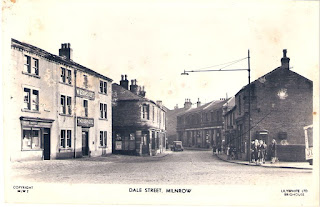 |
| Cottage handloom weaver at work. (Image from Wikimedia.org) |
Over time, fellmongering (processing sheep skins and hides) became an important industry and Milnrow was home to what was, reputedly, the largest fellmongering yard in England, owned by William Clegg Company. Tens of thousands of hides were brought in each week for processing.
Cotton milling, along with factory-based woollen milling, came to Milnrow in the early 19th century. The damp climate and ready access to coal to run the engines that powered the mills made this region ideal for cotton milling. Multi-storied brick edifices with tall chimneys dotted the landscape. Long rows of new houses went up, many of them built by the mill owners, to accommodate the workers. The railway line arrived in Milnrow in 1863. Originally part of the Butterworth township in the Rochdale parish, Milnrow gained its own Urban District Council in 1894. By 1901 the population had grown to about 10,000 people.
 |
| Tram car in Dale Street, maybe c1910, with one of the mills in the background* |
Their son Matthew, who had married in Rastrick in 1890, was already living in Milnrow when his wife Elizabeth gave birth to their second child, Annie, in June 1892. So it's possible that Matthew and Elizabeth moved to Milnrow first, and John, Mary Ann and the rest of the family followed.
 |
| Dale St, Milnrow. This photo is from a later date, but the Ward's shop must have been on this corner*. |
 |
| St James parish church, Milnrow* |
During World War 1, many men from Milnrow enlisted. The local war memorial shows that 144 of them never returned. John and Mary Ann's two older sons, John Willie and Matthew, were too old to join up. The youngest, Thomas, already in his thirties, probably thought he too would be overlooked. But he was enlisted, and sent to Mesopotamia as a member of the Royal Army Ordnance Corp. He did his training in Colchester, in Essex, which is where he met his future wife. That is where we will go to next in this series.
And since we are now leaving the clog-making Ward family of Lancashire, I thought I'd share this poem (in dialect) about clogs.
IT DIDN’T SEEM REET - Anon.
Wen a fella cum walkin’ deawn eawr road,
‘Is clogs went "er—clatt, er—clatt."
An’ it struck mi, as Ah’d never knowed
A pair o’clogs t’seawnd like that.
Soo Ah waited wile ‘ee getten close,
Fer t’see wot wer th’matter,
Clogs doant "er—clatt, er—clatt" tha knows
Thi should guh "clatt—er, clatt—er!"
Ah thowt, "Just wen ‘as passes mi
Ah’ll ‘ev a looka’t’greawnd,
Cause Ah wer fair reet wonderin’
O’er th’reason feryon seawnd.
Sos wen ‘ee sad, "Nah then theer,"
Wen ‘ee passed mii’ th’ street,
Ah looked, an’ does ta know
Booath ‘is clogs wero’t’wrong feet.
*My thanks to Steve, owner of the wonderful Old Milnrow Pinterest board, for allowing me to use these photos.
Oh, I love the poem. I could just imagine an old codger hovering as the different sounding clogs went by and he realised why they were different.
ReplyDeleteYour posts are always interesting, thanks.
Nan
Thanks Nan, I'm glad you liked the poem as much as I did.
ReplyDeleteCongratulations ! Your blog is included in INTERESTING BLOGS in FRIDAY FOSSICKING at
ReplyDeletehttps://thatmomentintime-crissouli.blogspot.com/2019/04/friday-fossicking-5th-april-2019.html
Thank you, Chris